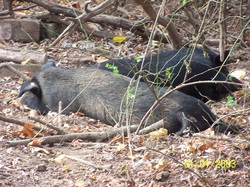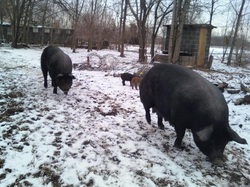American Mulefoot Hogs

Lazy day!
Although we no longer raise them, we love the breed.
No one really knows where this hog originated. No one knows how many resources, including scholarly works, journal and newspaper articles, herd books, and so forth, have been lost. Those included here are some of the few available. A short review of available resources on Google Books reveals that the Mulefoot, or Mule-Foot, was never mentioned even as late as 1906, but by 1920 herds were fairly prevalent, especially in the Midwest. The popularity of the breed seems to have grown until industrialized pork production and the longer, leaner hog with large litters and abundant pork chops became the norm. Since the Mulefoot is suitable to none of these conditions it lost popularity until it was all but extinct. Thankfully, today many people recognize that great pork is not lean, pork chops aren't the only good cut, and large litters aren't always desirable and the Mulefoot Hog is making at least a small comeback.
No one really knows where this hog originated. No one knows how many resources, including scholarly works, journal and newspaper articles, herd books, and so forth, have been lost. Those included here are some of the few available. A short review of available resources on Google Books reveals that the Mulefoot, or Mule-Foot, was never mentioned even as late as 1906, but by 1920 herds were fairly prevalent, especially in the Midwest. The popularity of the breed seems to have grown until industrialized pork production and the longer, leaner hog with large litters and abundant pork chops became the norm. Since the Mulefoot is suitable to none of these conditions it lost popularity until it was all but extinct. Thankfully, today many people recognize that great pork is not lean, pork chops aren't the only good cut, and large litters aren't always desirable and the Mulefoot Hog is making at least a small comeback.
From the American Livestock Breeds Conservancy:

Looking for something to eat in the snow.
The Mulefoot is an American hog breed that is named for its most distinctive feature, the solid, non-cloven hoof which looks like the hoof of a mule. This characteristic will occasionally occur as a single gene mutation, producing occasional “mulefooted” pigs within a variety of other breeds. In contrast, the Mulefoot breed is consistent in appearance and behavior, with qualities that have made it valuable in American history and a conservation priority today.
The origin of the Mulefoot is unclear, and many theories have arisen about its links with mulefooted stocks in Asia and Europe. The breed is more likely to have descended from the Spanish hogs brought to the Americas beginning in the 1500s. It shares some attributes with the Choctaw hog, and the two breeds likely come from the same ancestral stock, which was loosely selected and managed until the late 1800s.
By 1900, the Mulefoot had become a standardized breed. It was valued for ease of fattening and production of meat, lard, and especially hams. Mulefoot hogs were distributed throughout the Corn Belt. They were also common along the Mississippi River Valley, where farmers ranged their hogs on the islands in the river, putting them out to forage in the spring and collecting them in the fall. In the early 1900s there were two Mulefoot breed associations and over 200 herds registering purebred stock.
Mulefoot hogs are compact in appearance and weigh 400–600 pounds. They are solid black with white points occurring rarely. The ears are pricked forward. Some pigs have wattles on either side of the neck, though this is not common. The breed forages well and thrives under extensive husbandry. They have litters of 5-6 piglets but may have as many as 12. The sows make excellent and calm mothers.
The Mulefoot breed is critically rare. As of 2006 there are fewer than 200 purebred hogs documented. Most of these originated in the Holliday herd of Missouri, which is believed to be the last purebred herd in existence.
Status: Critical